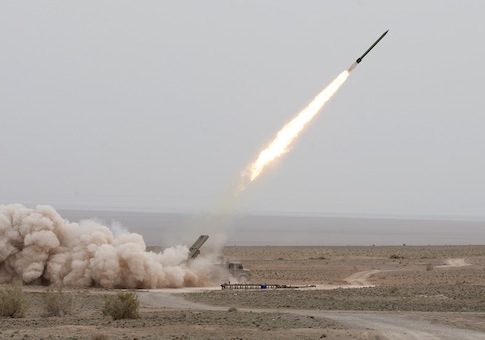http://freebeacon.com/iran-news-iran-missile-program-utilizing-space-launcher-for-cover/
 U.S. intelligence indicates that Iran has conducted multiple launches of a space launcher that are cover for the development of an intercontinental ballistic missile (ICBM) that could reach the United States, according a new threat report jointly issued by the National Air and Space Intelligence Center (NASIC) and the Office of Naval Intelligence.
U.S. intelligence indicates that Iran has conducted multiple launches of a space launcher that are cover for the development of an intercontinental ballistic missile (ICBM) that could reach the United States, according a new threat report jointly issued by the National Air and Space Intelligence Center (NASIC) and the Office of Naval Intelligence.
The successful launch of these multiple space vehicles demonstrates that Iran could have the technology needed to build an ICBM capable of striking America, according to the report.
Iran “has conducted multiple successful launches of the two-stage Safir space launch vehicle (SLV) and has also revealed the larger two-stage Simorgh SLV, which could serve as a test bed for developing ICBM technologies,” according the report.
“Since 2008, Iran has conducted multiple successful launches of the two-stage Safir SLV,” according to the report. “In early 2010, Iran unveiled the larger Simorgh SLV.”
The report determined that Iran “will likely continue to pursue longer range ballistic missiles and more capable SLVs, which could lead to the development of an ICBM system.”
“Iran could develop and test an ICBM capable of reaching the United States by 2015,” the intelligence report concludes.
U.S. missile defense systems in Europe have been built to combat this potential threat. However, the recent cancelation of a key piece of the system at Russia’s behest could leave the United States vulnerable.
While the NASIC report provides few details on Iran’s missile programs, a 2009 State Department cable determined that “Iran has the largest and most active missile program in the Middle East.”
The latest NISAC report found that “Iran has an extensive missile development program and has received support from entities in Russia, China, and North Korea.”
Tehran takes great pride in its defense program, routinely testing its weaponry in public and boasting of its military prowess.
“Iran has ambitious ballistic missile and space launch development programs and continues to attempt to increase the range, lethality, and accuracy of its ballistic missile force,” the report states.
“Iranian ballistic missile forces continue to train extensively in highly publicized exercises,” according to the report. “These exercises enable Iranian ballistic missile forces to hone wartime operational skills and evolve new tactics.”
Iran continues to improve “its existing [missile] inventory and is developing the technical capability to produce an ICBM,” according to the report.
Iran possesses somewhere near 100 medium range missiles that can travel anywhere from 125 to 310 miles, according to the report. It is believed to have fewer than 50 missiles that can travel around 1,300 miles.
Iran has been making progress on the long-range missile front since at least 2010.
“Since 2010, Iran has revealed the Qiam-1 SRBM, the fourth generation Fateh-110 SRBM, and claims to be mass-producing anti ship ballistic missiles (ASBMs),” the report states.
Iran has additionally “modified its Shahab 3 medium-range ballistic missile (MRBM) to extend its range and effectiveness and also claims to have deployed the two-stage, solid-propellant Sejjil MRBM,” the report found.
Some of Iran’s more advanced missiles are meant to strike ships.
This could prove critical for Tehran as it attempts to gain control of the critical Straits of Hormuz, a shipping lane through which most of the world’s oil passes.
“Iran claimed to have also successfully flight tested a fourth-generation Fateh-110,” according to the missile report. “Iran has also flight tested an ASBM variant of its Fateh-110 missile. A seeker has likely been added to the missile to improve the system’s accuracy against sea-based targets.”
The report additionally concludes that Iran has tested nuclear weapons.
Many of Tehran’s missiles are modified versions of weapons they have received from North Korea and Russia, according to the report.
The Iranian Shahab 3 medium-range missile “is based on the North Korean No Dong missile,” according to the report.
“Iran has modified the Shahab 3 to extend its range and effectiveness, with the longest range variant reportedly being able to reach targets at a distance of about 2,000 km,” which is the distance needed to strike deep into the heart of Israel.
“In addition, Iran has conducted multiple launches of the Safir, a multi-stage SLV [satellite launch vehicle] that can serve as a test bed for long-range ballistic missile technologies,” according to the report.
Former Pentagon adviser Michael Rubin said Iran’s space program is cover for its ballistic missile work.
“Every time the Iranians announce progress on their satellite program, American officials should cross out satellite launchers and repeat the same phrase with intercontinental ballistic missiles substituted because launching satellites and ICBMs use the same basic technology, and the former can be the cover for the latter,” said Rubin.









